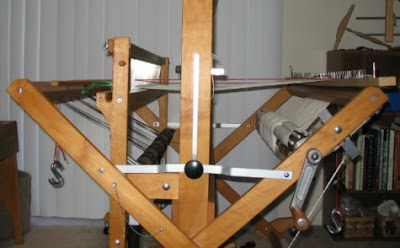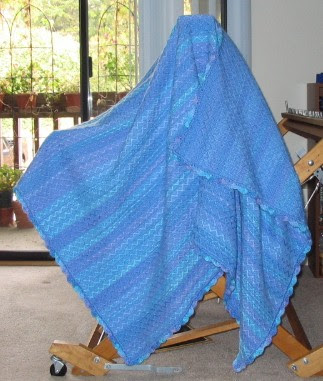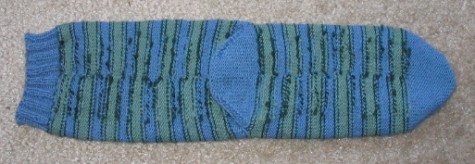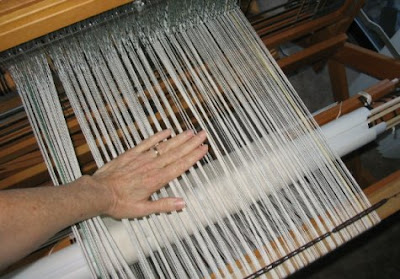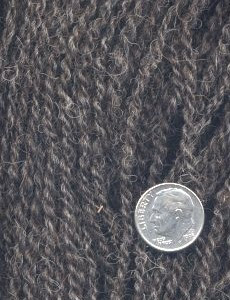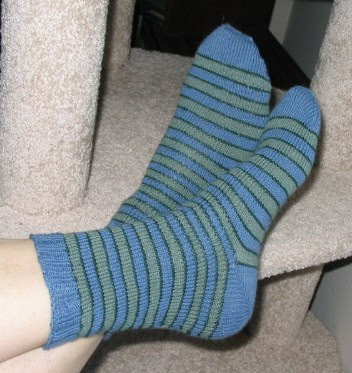I will be the first to admit that I am an exceptionally poor judge of volume. I can never put away leftovers without dirtying at least two containers; the first one I choose is always either too big or too small. Along the same line, I have never been able to judge how much to fill two singles bobbins so that I don't have any leftovers after plying. Even weighing the unspun fiber doesn't help, as my spinning isn't entirely consistent. I'm sure I'm not alone in this plying problem, but it bugs me to no end to have bobbins cluttered up with leftover singles.
After struggling with this for several years, I finally decided that I needed to learn to ply from a center pull ball. There are several ways to make these, but I learned to do it with a ball winder. I use my ball winder for balling skeins of yarn off my swift too, so it is a useful tool to have around.
I wind the singles onto the winder directly from the bobbin. The yarn I am plying here is the white Shetland from the second batch from Cathy.

Before taking the ball off the winder, it is important to find the two ends. One comes from the inside of the ball, where it was secured in a notch on the core of the winder. The other is on the outside. I knot them before removing the yarn.
Next, it is ready to tie onto the leader yarn on the bobbin I plan to use for plying.

I secure the tied singles to the leader by first folding them over and through the leader loop. Then I pull the knot back through the loop created by the singles. When this is snugged up, I find that the singles are quite secure. After plying, it is easy to remove the yarn from the leader by pulling the knot back through the loop. No cutting needed.
I like to use one of my cabled yarns as a bobbin leader. Cabled yarns seem to withstand both directions of twisting than do ordinary yarns.
Getting started is a little tricky, and I have to admit that learning how to do this took some time and practice. The key to plying from a center pull ball is to keep both singles at the same tension during the plying. Otherwise, the looser single wraps itself around the tauter one. This is ok for certain designer yarns, but not okay for 'plain vanilla' type yarns.
 You can see the hand position that works for me in the photo on the left. The actual position of the hand isn't critical; you may need to experiment a little to find what works for you. What's important is keeping the tension of the two singles the same.
You can see the hand position that works for me in the photo on the left. The actual position of the hand isn't critical; you may need to experiment a little to find what works for you. What's important is keeping the tension of the two singles the same.When I first start plying, I treadle enough to get the twist started, then stop to make adjustments. One ply comes from the center of the ball, and the other unwinds off of the outside of the ball, but they do not unwind evenly! That means I may need to adjust my hand position or hand movements. Actually, I move the hand holding the ball very little, if at all during plying. I just keep an eye on the two singles as they unwind, and try to keep them the same length and tension.
The first few yards are where I experiment with the number of treadles I'll need to match the 2-ply on my sample card.

My sample card contains a short piece of freshly plied yarn off the bobbin. This shows me how the yarn wants to ply back on itself to balance the twist. To figure this out for plying, I count the number of treadles for a comfortable length of yarn, and then compare. The specific length isn't important as long as it is manageable for the spinner and remains consistent. If my 2-ply isn't perfect at first, I don't sweat it because the ends of a skein are often wasted anyway.
I like the sample card comparison method of determining the amount of twist needed, as it is more accurate with singles that have been sitting around on the bobbin. Sitting yarn tends to temporarily set its twist, so unless the twist is revived, it's hard to judge how much to ply it.
Once I establish a treadle count, I can get a rhythm going.


pinch the point of twist, and let the plied yarn feed into onto the bobbin. As I feed in, the singles are pulled gently from the ball. If I need to, I stop treadling in order to reposition my hands to get an even tension.
One potential problem can be if the center of the ball pulls out like (click here) this. That doesn't happen often, mostly if the singles are very fine, or the fiber somewhat slippery. In that case, it's better to make smaller balls to work with.Another thing I like about the center pull ball, is that it's easy to take a break.......

The center of the ball fits nicely onto the tension knob (which isn't really used for anything anyway as this wheel is set up double drive.)
Plying from a center pull ball, like spinning itself, is an activity that is learned kinestetically. Descriptions and demonstrations may be helpful, but in the end one has to learn by doing it. It is something the hands have to learn as well as the mind. That requires experimentation and practice. These in turn require patience with oneself and one's efforts. Not easy for those of us with a streak of perfectionism! Still, to me it was worth it.



